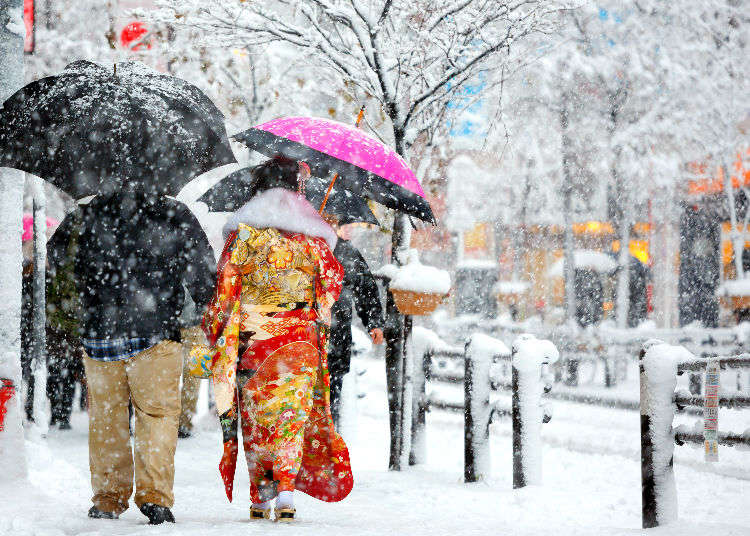
Does Tokyo get snow? If so, how much snowfall does Tokyo see? Many people who visit Tokyo during the winter are impressed by the snowscape of the city. Even amidst the bustle of Tokyo, the white snow drifting down appears to slow down the flow of time, creating a different image of the city than usual.
Watching the snowfall in the unfamiliar town of an unfamiliar new country can be one of the most unforgettable memories of your life. So if you happen to take the time to visit Tokyo during the snowy season, please enjoy the changing shape of the city under the snow.
So how often can you actually see snow in Tokyo? We estimate the snowfall probability in Tokyo in reference to the snowfall amount and the number of snow days by the Meteorological Agency of Japan.
1. What is Tokyo’s Winter Climate Like?
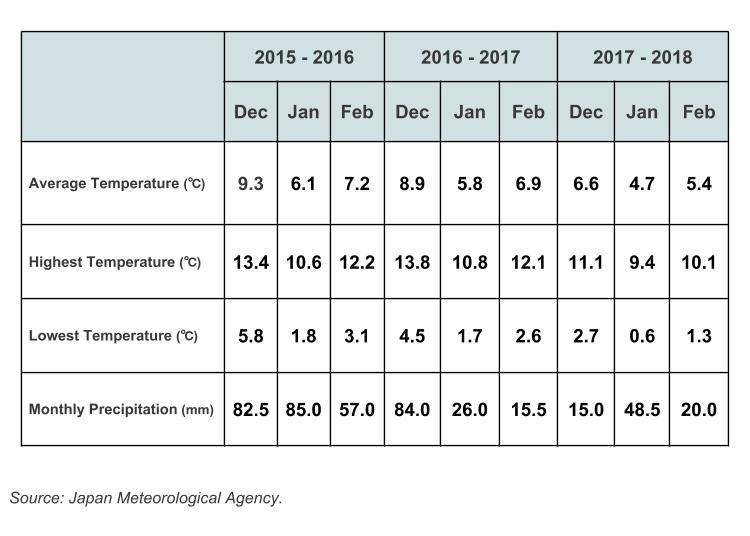
According to the chart, which shows the winter climate change in Tokyo from 2015 to 2018, there was a tendency for the average temperature to drop by 2 to 3 degrees from December to January. The cold also appears to peak during these months.
Also, because the temperature in January generally hits a low of less than 2 degrees (C), make sure to prepare against the cold when sightseeing around Tokyo properly. Dress appropriately, such as thick coats and hats, and don't forget your gloves and scarves.
2. Tokyo Gets Snow About 7.6 Times per Season, Mainly in January and February
- Year
- Snow Days (Cold year)
- 2018
- 23
- 2017
- 0
- 2016
- 6
- 2015
- 3
- 2014
- 27
- 2013
- 8
- 2012
- 4
- 2011
- 2
- 2010
- 1
- 2009
- 0
*The cold weather year is indicated by the period between August 1 of the previous year and July 31 of the current year. For example, the cold weather year indicated here is the period from August 1, 2017, to July 31, 2018. Source: JMA
Looking at the number of snow days in Tokyo over the past 10 years, the year with the most snowfall was 2010 with 14 days, and the year with the least was 2013 with only 5 days.
The average number of snow days in the past 10 years is 9.6 days. This means that the opportunity to see snow in Tokyo is limited to about 10 times a year.
So when exactly is the best time with the highest possibility to see snow in Tokyo?
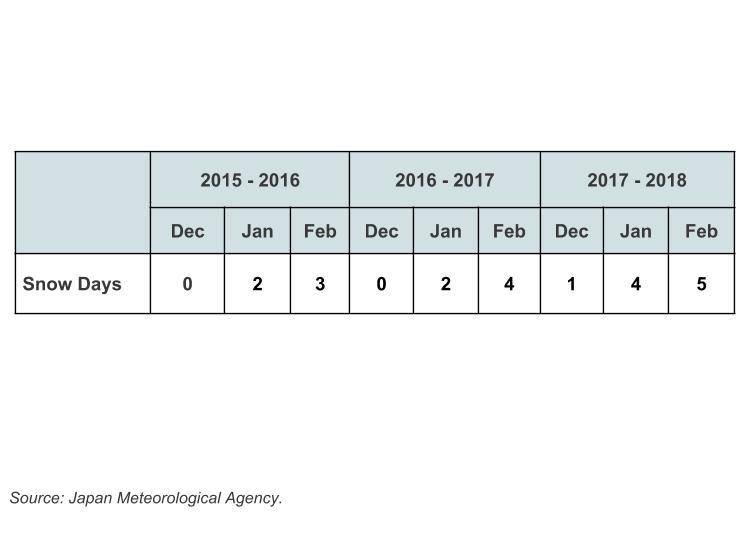
Looking at the number of snow days by month over the past 3 years, we can see that these days are most concentrated through January and February, when the temperature reaches the biggest drop during the year.
If you want to enjoy seeing snowy Tokyo, the best bet would be to visit between January and February.
3. What kind of weather conditions must be met to see snow in Tokyo?

There is a possibility for snowfall on a day when the temperature is between 0 to 2 degrees (℃) and humidity is low. In brief, as summed up by this single sentence, we understand that a low temperature is one of the biggest concerns regarding snow conditions.

In the upper atmosphere, snow exists regardless of the season; however, it only appears on the earth's surface as snow if the temperature is low enough. On the other hand, if the temperature is too high, the structure of the snow will melt and fall as rain.
In other words, the temperature must remain low for the snow to reach the Earth's surface as snow. One theory also states that when the temperature is roughly 2 degrees (C) or below, atmospheric pressure becomes another key factor affecting snowfall.
Generally, when the 'south coast low pressure' passes south of the Hachijo-jima Islands located south of Tokyo, there is a high possibility that the moist air from the low pressure will cool in the upper-air sky, and snow will fall around Tokyo.
However, it is still difficult even for professional weather forecasters to accurately predict snowfall dates just by reading the air pressure. Therefore, it is probably much simpler and more appropriate to remember that "there is a possibility that snow may fall when the temperature is between 0 to 2 degrees (℃), and humidity is low."
4. Does Tokyo get a lot of snow?
- Year
- Deepest Snowfall (cm)
- 2018
- 23
- 2017
- 0
- 2016
- 6
- 2015
- 3
- 2014
- 27
- 2013
- 8
- 2012
- 4
- 2011
- 2
- 2010
- 1
- 2009
- 0
How much snow falls in Tokyo? Looking at the max snowfall amount over the past 10 years, the most snow accumulated was in 2014, at about 27 cm high, or knee-depth.
While it wasn't enough to make walking impossible, it was a dangerous amount for people traveling by bicycle or motorcycle.
It also impacted various transportation facilities, causing delays and cancellations for most Tokyo railways, and road closings on some highways connecting Tokyo with other regions.
One should bear in mind that when snowfall in Tokyo reaches an amount high enough to classify it as 'heavy,' it is likely to have the biggest impact on transportation.
Now, what about snowfall in Nagoya and Osaka, two other major Japanese cities in line with Tokyo?
5. Tokyo Snowfall Compared to Nagoya and Osaka

Compared with Osaka and Nagoya, the number of snow days in Tokyo is smaller throughout the year, while snow accumulation tends to be greater. However, in Osaka, the number of snow days is greater than in Tokyo, yet snow accumulation rarely reaches over 5 cm.
Compared with other major cities of Japan, we can see that the amount of snowfall in Tokyo is relatively large.
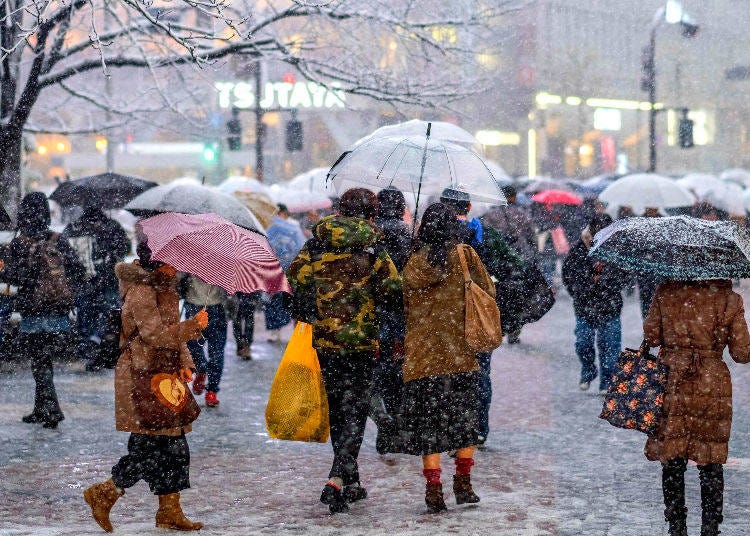
Advantages of Snowfall in Tokyo:
・In place of the usually cold, robotic, high-rise-lined streets of Tokyo City, fantastic winter scenery can be seen.
・You can enjoy a different kind of sightseeing experience at popular tourist spots such as Tokyo Tower, Skytree, and Senso-ji in Asakusa.
Disadvantages of Snowfall in Tokyo:
· Train delays and cancellations
· Road congestion
· Highway closings
· Flight cancellations
· Slippery ground, increased chance of injury while walking
Conclusion
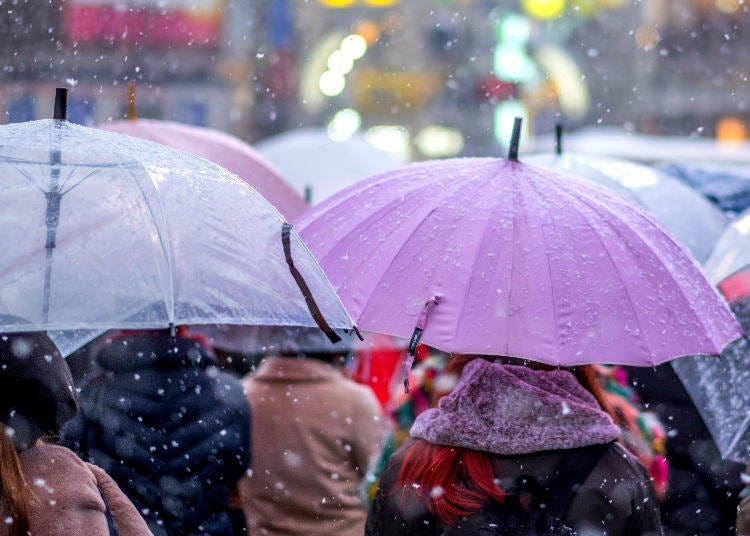
In conclusion, yes, you can definitely experience snowfall in Tokyo. Compared with other major cities of Japan, such as Nagoya and Osaka, though snowfall days in Tokyo are few, it can be as heavy as 20cm in depth when snow does fall.
If you want to sightsee around Tokyo's snowy landscape, the best recommended period to do so is between January and February, when the temperature reaches its lowest point in the year.
If you are lucky enough to experience the snowy days of Tokyo, the winter scenery of the city is sure to become a memory you will cherish for the rest of your life.
- Area
- Category
*Prices and options mentioned are subject to change.
*Unless stated otherwise, all prices include tax.
Popular Tours & Activitiess
Recommended places for you
-

Tsukiji Outer Market
Old Towns (Shitamachi)
Tsukiji
-

The Imperial Palace
Other Architecture
Tokyo Station
-

Tokyo Metropolitan Government
Landmarks
Shinjuku
-

Shinjuku Gyoen National Garden
Gardens
Shinjuku
-

Ueno Zoo (Ueno Zoological Gardens)
Zoos, Aquariums & Botanical Gardens
Ueno
-

Naritasan Shinshoji Temple
Temples
Narita
-
Ad

Discover the "Miraculous Forest" in the Heart of Tokyo: The Institute for Nature Study (9 Minutes from JR Meguro Station)
-
Ad

Complete Guide to Ueno's National Museum of Nature and Science, the Perfect Place to Visit on Rainy Days or With Children
-

This Winter, Godzilla Takes Over Haneda Airport
by: Guest Contributor
-

First Japan Cherry Blossom 2026 Forecast Announced! Here's When & Where to See Sakura in Japan
-

New in Ginza! Air BicCamera Ginza Opens with a Faster, More Convenient Shopping Experience
by: Guest Contributor
-
Ad

(Opening in Jan 2026) 'THE SUMO LIVE RESTAURANT HIRAKUZA GINZA TOKYO!' 5 Exciting Ways to Experience the World of Sumo!
Inspiration for Accommodations
-

Enjoy Mt. Fuji from the Comfort of Your Room! Recommended Ryokan with Mt. Fuji View
-

Stay Near the Cherry Blossoms! Hotels for Cherry Blossom Viewing in Tokyo
-

Family-Friendly Hotels with Free Shuttle to Disneyland: Convenient Access for a Magical Stay
-

Top Ranked Hakone Hotels with Mt. Fuji View: Enjoy Stunning Scenery from Your Private Space
-

Convenient Tokyo Hotels with Airport Shuttle: Ideal for Families and Heavy Luggage
-

Stunning Tokyo Tower View Hotels: Enjoy Spectacular Scenery from Your Private Space
-

Convenient Asakusa Hotels with Kitchens: Ideal for Extended Family Visits
-

Experience Luxury: Hakone's 10 Best Five-Star Accommodations
-

Enjoy Mt. Fuji Autumn Leaves! Top Hotels Near the Popular Autumn Leaves Corridor
-

Experience Hakone Fall Foliage from Your Room with Stunning Views
-

Complete Guide to Buying Japanese Medicine in Japan: Phrases and Vocabulary You Need to Know
-

Healthcare in Japan for Tourists: What to Do When You Get Sick or Injured in Japan
-

Japan Braces for Snowstorm Shock Thru January 10—Here's How to Travel Safely
-

Japan Winter 2025: National Holidays, Seasonal Festivals & Must-See Spots
by: Chien-Huang
-

Winter Sightseeing in Tokyo Done Right: What to Know and What to Bring
-

Shine Bright This Winter: 15 Must-See Tokyo Illuminations (2025-2026)
by: Kaori Kimura
- #best ramen tokyo
- #what to buy in ameyoko
- #what to bring to japan
- #new years in tokyo
- #best izakaya shinjuku
- #things to do tokyo
- #japanese nail trends
- #what to do in odaiba
- #onsen tattoo friendly tokyo
- #daiso
- #best sushi ginza
- #japanese convenience store snacks
- #best yakiniku shibuya
- #japanese fashion culture
- #best japanese soft drinks












